The International Watershed Coordinator—Keeping Us Working Together.
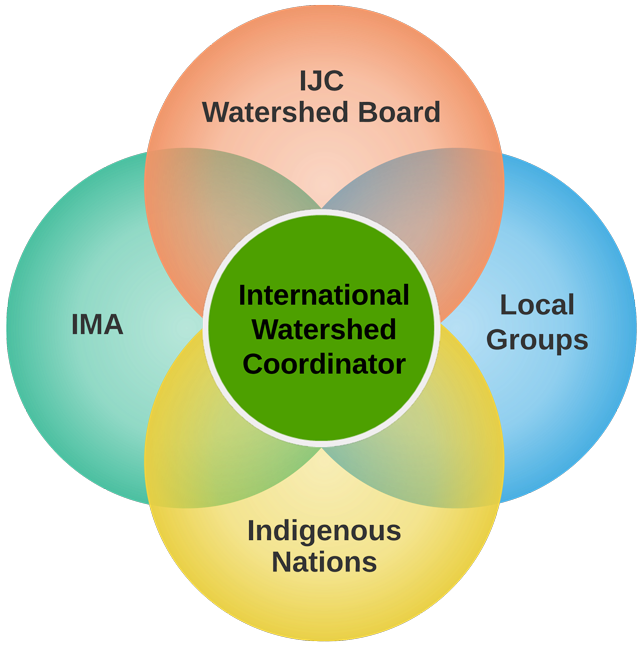 Meghan Mills is the Foundation's International Watershed Coordinator, a dedicated resource to support and coordinate research, management and civic engagement initiatives underway internationally across our watershed. Meg focuses on working together with four main spheres of activity in the watershed:
Meghan Mills is the Foundation's International Watershed Coordinator, a dedicated resource to support and coordinate research, management and civic engagement initiatives underway internationally across our watershed. Meg focuses on working together with four main spheres of activity in the watershed:
- International Joint Commission (IJC) and its International Rainy-Lake of the Woods Watershed Board (IRLWWB)
- The International Multi Agency Arrangement (IMA) research and management collaboration.'
- Indigenous Nations
- Local groups and agencies engaged in watershed activities throughout the bi-national basin.
- Details
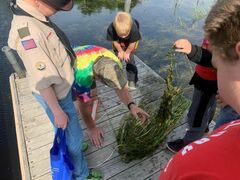 Over 206 volunteers searched a total of 281 accesses on 222 water bodies across Minnesota on Saturday, August 21, 2021 to participate in Starry Trek. Starry Trek is a statewide search for starry stonewort and other aquatic invasive species at public water accesses. The state-wide effort is organized by the Minnesota Aquatic Invasive Species Research Center (MAISRC) and University of Minnesota Extension in partnership with Minnesota Department of Natural Resources.
Over 206 volunteers searched a total of 281 accesses on 222 water bodies across Minnesota on Saturday, August 21, 2021 to participate in Starry Trek. Starry Trek is a statewide search for starry stonewort and other aquatic invasive species at public water accesses. The state-wide effort is organized by the Minnesota Aquatic Invasive Species Research Center (MAISRC) and University of Minnesota Extension in partnership with Minnesota Department of Natural Resources.
- Details
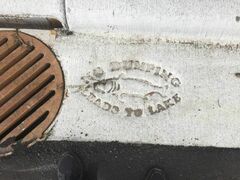 Painting messages beside storm drains to help the public understand that only rain should go down the drain, because they divert water to either the Rainy River or Lake of the Woods, began several years ago as a cross-border project in Fort Frances, ON and International Falls, MN. The project has grown every year with Kenora, ON and Ranier, MN both taking part and last year, Baudette, MN joined in! This year was no different. Kenora, ON and Baudette, MN both took on the project again and it was a huge success in both communities.
Painting messages beside storm drains to help the public understand that only rain should go down the drain, because they divert water to either the Rainy River or Lake of the Woods, began several years ago as a cross-border project in Fort Frances, ON and International Falls, MN. The project has grown every year with Kenora, ON and Ranier, MN both taking part and last year, Baudette, MN joined in! This year was no different. Kenora, ON and Baudette, MN both took on the project again and it was a huge success in both communities.
- Details
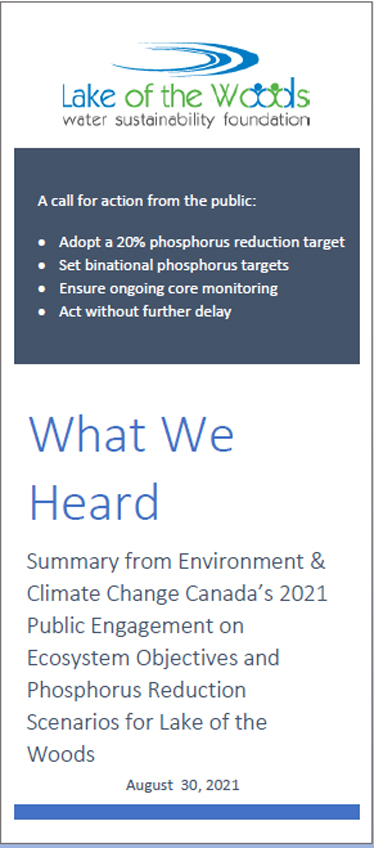 LOWWSF has released a report summarizing what we heard from the public during engagement sessions with Environment and Climate Change Canada on its set of proposed lake ecosystem objectives and potential phosphorus reduction scenarios to improve water quality for Lake of the Woods. Hundreds participated in ten webinars and online via ECCC's Lake of the Woods engagement website. The messages were clear and a call to action -- "get on with it":
LOWWSF has released a report summarizing what we heard from the public during engagement sessions with Environment and Climate Change Canada on its set of proposed lake ecosystem objectives and potential phosphorus reduction scenarios to improve water quality for Lake of the Woods. Hundreds participated in ten webinars and online via ECCC's Lake of the Woods engagement website. The messages were clear and a call to action -- "get on with it":
- Adopt a 20% phosphorus reduction target
- Set binational phosphorus targets
- Ensure ongoing core monitoring
- Act without further delay
pdf Download the report here(551 KB)
- Details
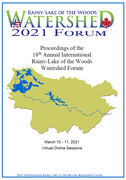 The Proceedings Report of the 2021 International Rainy-Lake of the Woods Watershed Forum is available for download at the Foundation’s website: lowwsf.com/forum-proceedings .Held March 10-11, via Zoom due to Covid-19, over 180 researchers, resource managers, policy makers and members of the public put Lake of the Woods and its watershed under the microscope. The report covers a wide range of subjects: including: watershed governance, aquatic invasive species, nutrients and algae, water regulation and monitoring.
The Proceedings Report of the 2021 International Rainy-Lake of the Woods Watershed Forum is available for download at the Foundation’s website: lowwsf.com/forum-proceedings .Held March 10-11, via Zoom due to Covid-19, over 180 researchers, resource managers, policy makers and members of the public put Lake of the Woods and its watershed under the microscope. The report covers a wide range of subjects: including: watershed governance, aquatic invasive species, nutrients and algae, water regulation and monitoring.
Most presentations were recorded and are available for viewing for a limited time at lowwsf.com/forum-presentations.
Please download a copy of the report or go to the website to view any presentation recordings that are of interest to you.
- Details
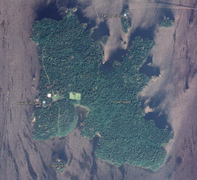 The Nature Conservancy of Canada (NCC) is a non-profit organization that works to protect natural areas through securing properties and managing them for the long term, ensuring their ecological integrity. NCC is partnering with the City of Kenora, local residents, cottagers, and campers to protect 82 hectares (202 acres) on Town Island.
The Nature Conservancy of Canada (NCC) is a non-profit organization that works to protect natural areas through securing properties and managing them for the long term, ensuring their ecological integrity. NCC is partnering with the City of Kenora, local residents, cottagers, and campers to protect 82 hectares (202 acres) on Town Island.
- Details
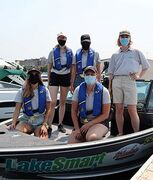 LakeSmart is an award-winning environmental outreach program unique to the Lake of the Woods area of northwestern Ontario. A signature program of the our sister organization, the Lake of the Woods District Stewardship Association (LOWDSA), it is focused on environmental education and helping lake users “live and play green” at the lake. The LakeSmart Boat is now launched and the team looks forward to visiting you.
LakeSmart is an award-winning environmental outreach program unique to the Lake of the Woods area of northwestern Ontario. A signature program of the our sister organization, the Lake of the Woods District Stewardship Association (LOWDSA), it is focused on environmental education and helping lake users “live and play green” at the lake. The LakeSmart Boat is now launched and the team looks forward to visiting you.
To contact the LakeSmart team or to book a visit: email
- Details
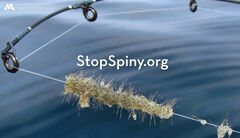 Spiny waterfleas are small aquatic predators native to Eurasia. The first report of spiny waterfleas in North America was in Lake Ontario in 1982 and was introduced to the Great Lakes in ballast water from ocean-going ships. “Spiny” is a species of zooplankton – small animals that rely on water currents and wind to move long distances. They prefer large, deep, clear lakes, but can also be found in shallower waters.
Spiny waterfleas are small aquatic predators native to Eurasia. The first report of spiny waterfleas in North America was in Lake Ontario in 1982 and was introduced to the Great Lakes in ballast water from ocean-going ships. “Spiny” is a species of zooplankton – small animals that rely on water currents and wind to move long distances. They prefer large, deep, clear lakes, but can also be found in shallower waters.
- Details
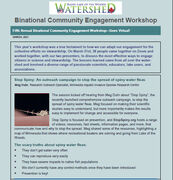 This year’s workshop was a true testament to how we can adapt our engagement for the collective efforts on stewardship. On March 31st, 38 people came together on Zoom and worked together, with our two presenters, to discuss the most effective ways to engage citizens in science and stewardship. The lessons learned came from all over the watershed and involved a diverse range of passionate scientists, educators, lake users, and associations.
This year’s workshop was a true testament to how we can adapt our engagement for the collective efforts on stewardship. On March 31st, 38 people came together on Zoom and worked together, with our two presenters, to discuss the most effective ways to engage citizens in science and stewardship. The lessons learned came from all over the watershed and involved a diverse range of passionate scientists, educators, lake users, and associations.
You can pdf download the report here!(296 KB)
- Details
Fourth Binational Lake Association Network Event in the books!
In the ongoing spirit of cross-border collaboration, the fourth international Lake Association Network Event took place virtually on November 24, 2020. A
pdf
summary report is available for download(449 KB)
. The half day workshop was attended by 24 individuals from Ontario and Minnesota, representing 15 different lake associations, resource agencies and organizations. The session was a mix of very practical and relevant presentations that covered green infrastructure ideas, how to establish an Environment Committee, a Q/A session on effective communication and a roundtable of association highlights.
Read more...
- Details
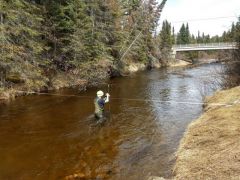 Originally published on August 20, 2020
Originally published on August 20, 2020
Since March 2018, Trent University has been in the basin studying nutrient (primarily phosphorus) delivery to Lake of the Woods from both watershed and atmospheric sources. It is well known that much of the nutrients that enter a waterbody are flushed in during storm events, so capturing that data is a definite challenge, especially when you don’t live here permanently. Thanks to local agencies and members of the public who are volunteering their time to help Trent, this is now possible, so more robust and indicative data are emerging.
Preliminary results of the data collected to date are showing that phosphorus export in the lower Rainy River tributaries (Everett Creek and Sturgeon, Lavallee and Pinewood Rivers) is strongly associated with sediment material, and the naturally erodible nature of the Rainy River area means that soils in this region are highly sensitive to disturbance.
